Controls on Nitrous Oxide Production in, and Fluxes from a Coastal Aquifer in Long Island, NY, USA
Abstract
:1. Introduction
2. Materials and Methods
2.1. Site Description
2.2. Field Sampling and Observations
2.3. Laboratory Analyses
2.4. Calculation of Excess N2, Emission Factors (EF5), and N2O Flux to Surface Waters
2.5. Statistical Analysis
3. Results
3.1. Spatial Distribution of Solutes and N2O Concentrations
3.2. Flux of N2O to Surface Waters
3.3. Emission Factor (EF5)
4. Discussion
4.1. N2O in Fresh and Saline Coastal Aquifers
4.2. Temporal Variation in N2O Production
4.3. N2O Flux Estimates and EF5
5. Conclusions
Acknowledgments
Author Contributions
Conflicts of Interest
Appendix A
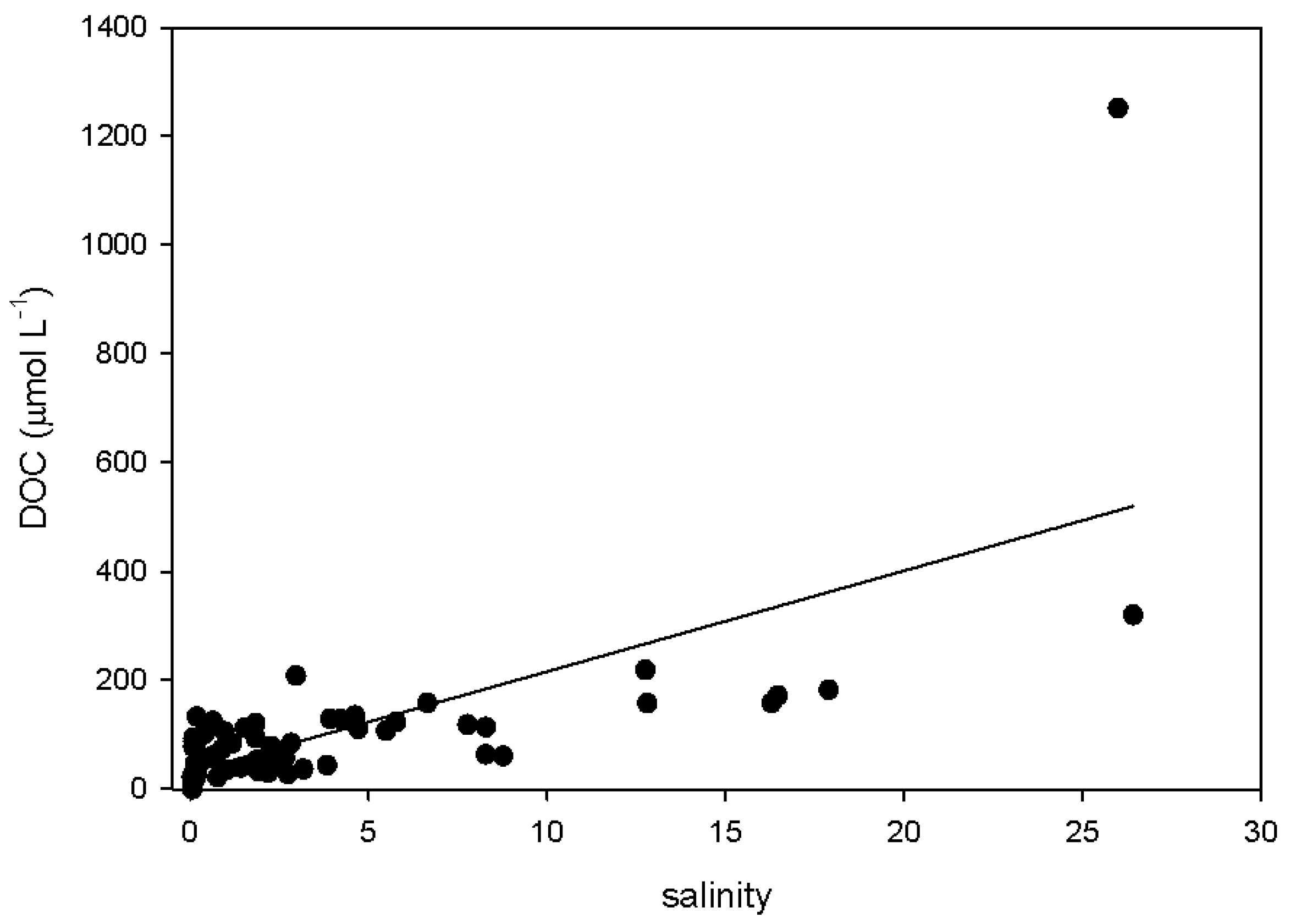
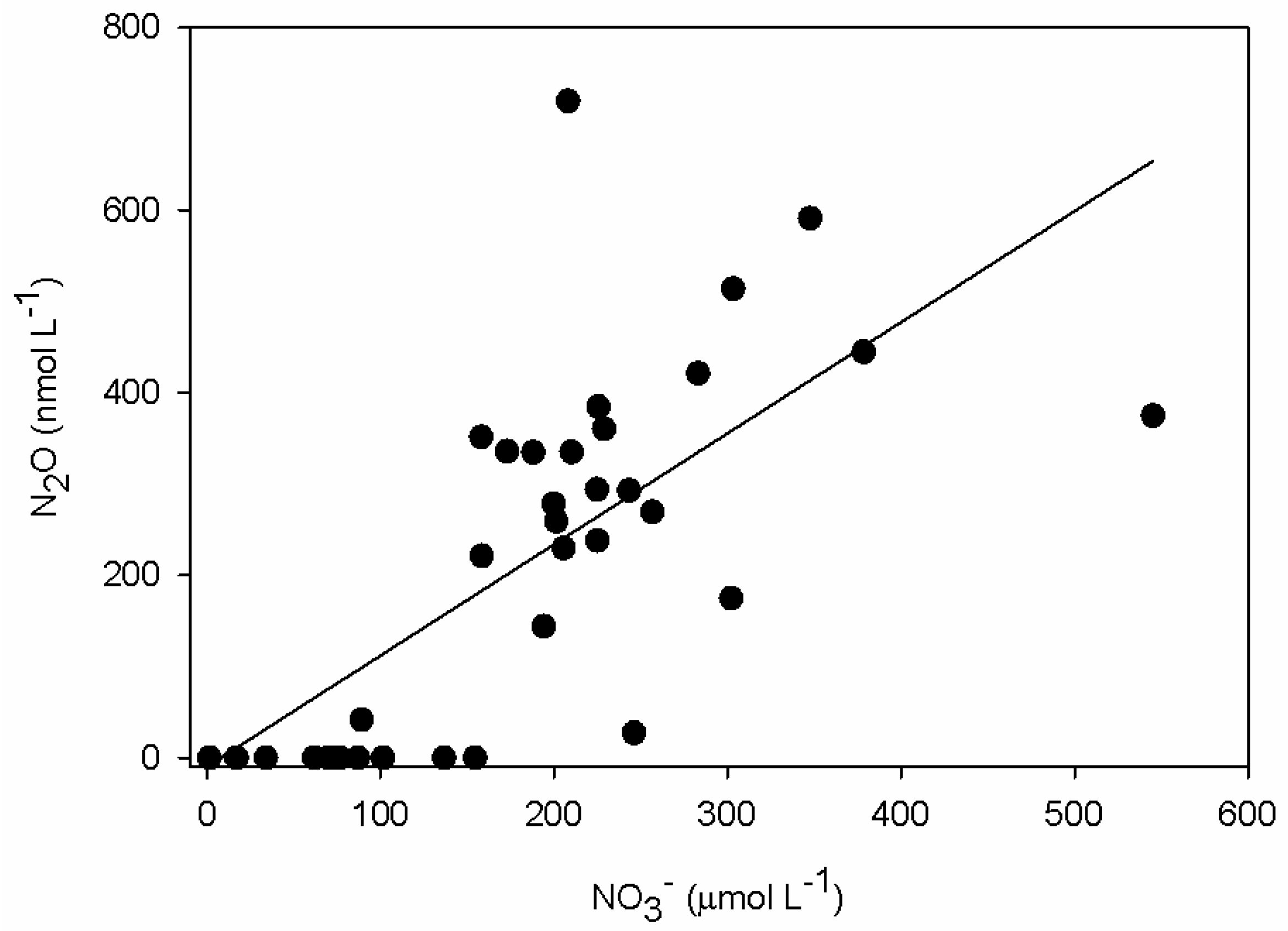
References
- Forster, P.; Ramaswamy, V.; Artaxo, P.; Berntsen, T.; Betts, R.; Fahey, D.W.; Haywood, J.; Lean, J.; Lowe, D.C.; Myhre, G.; et al. Changes in Atmospheric Constituents and in Radiative Forcing; Cambridge University Press: Cambridge, UK, 2007. [Google Scholar]
- Galloway, J.N.; Aber, J.D.; Erisman, J.W.; Seitzinger, S.P.; Howarth, R.W.; Cowling, E.B.; Cosby, B.J. The nitrogen cascade. Bioscience 2003, 53, 341–356. [Google Scholar] [CrossRef]
- Denman, K.L.; Brasseur, G.; Chidthaisong, A.; Ciais, P.; Cox, P.M.; Dickinson, R.E.; Hauglustaine, D.; Heinze, C.; Holland, E.; Jacob, D.; et al. Couplings between changes in the climate system and biogeochemistry. In Climate Change 2007: The Physical Science Basis. Contribution of Working Group I to the Fourth Assessment Report of the Intergovernmental Panel on Climate Change; Solomon, S., Qin, D., Manning, M., Chen, Z., Marquis, M., Averyt, K.B., Tignor, M., Miller, H.L., Eds.; Cambridge University Press: Cambridge, UK; New York, NY, USA, 2007. [Google Scholar]
- Erisman, J.W.; Sutton, M.A.; Galloway, J.; Klimont, Z.; Winiwarter, W. How a century of ammonia synthesis changed the world. Nat. Geosci. 2008, 1, 636–639. [Google Scholar] [CrossRef]
- Davidson, E.A. The contribution of manure and fertilizer nitrogen to atmospheric nitrous oxide since 1860. Nat. Geosci. 2009, 2, 659–662. [Google Scholar] [CrossRef]
- Nevison, C. Review of the IPCC methodology for estimating nitrous oxide emissions associated with agricultural leaching and runoff. Chemosphere Glob. Chang. Sci. 2000, 2, 493–500. [Google Scholar] [CrossRef]
- IPCC. Climate Change 2013: The Physical Science Basis. Contribution of Working Group I to the Fifth Assessment Report of the Intergovernmental Panel on Climate Change; Stocker, T.F., Qin, D., Plattner, G.-K., Tignor, M., Allen, S.K., Boschung, J., Nauels, A., Xia, Y., Bex, V., Midgley, P.M., Eds.; Cambridge University Press: Cambridge, UK; New York, NY, USA, 2013. [Google Scholar]
- Liu, L.; Greaver, T.L. A review of nitrogen enrichment effects on three biogenic GHGs: The CO2 sink may be largely offset by stimulated N2O and CH4 emission. Ecol. Lett. 2009, 12, 1103–1117. [Google Scholar] [CrossRef] [PubMed]
- Kroeger, K.D.; Charette, M.A. Nitrogen biogeochemistry of submarine groundwater discharge. Limnol. Oceanogr. 2008, 53, 1025–1039. [Google Scholar] [CrossRef]
- Roy, M.; Martin, J.B.; Cherrier, J.; Cable, J.E.; Smith, C.G. Influence of sea level rise on iron diagenesis in an east Florida subterranean estuary. Geochim. Cosmochim. Acta 2010, 74, 5560–5573. [Google Scholar] [CrossRef]
- Moseman-Valtierra, S.; Kroeger, K.D.; Crusius, J.; Baldwin, S.; Green, A.; Brooks, T.W.; Pugh, E. Substantial nitrous oxide emissions from intertidal sediments and groundwater in anthropogenically-impacted West Falmouth Harbor, Massachusetts. Chemosphere 2015, 119, 1281–1288. [Google Scholar] [CrossRef] [PubMed]
- Ward, B.B. Nitrification in marine systems. In Nitrogen in the Marine Environment, 2nd ed.; Elsevier Academic Press Inc.: San Diego, CA, USA, 2008; pp. 199–261. [Google Scholar]
- Murray, R.H.; Erler, D.V.; Eyre, B.D. Nitrous oxide fluxes in estuarine environments: Response to global change. Glob. Chang. Biol. 2015, 21, 3219–3245. [Google Scholar] [CrossRef] [PubMed]
- Slomp, C.P.; van Cappellen, P. Nutrient inputs to the coastal ocean through submarine groundwater discharge: Controls and potential impact. J. Hydrol. 2004, 295, 64–86. [Google Scholar] [CrossRef]
- Bratton, J.F. The three scales of submarine groundwater flow and discharge across passive continental margins. J. Geol. 2010, 118, 565–575. [Google Scholar] [CrossRef]
- Corredor, J.E.; Morell, J.M.; Bauza, J. Atmospheric nitrous oxide fluxes from mangrove sediments. Mar. Pollut. Bull. 1999, 38, 473–478. [Google Scholar] [CrossRef]
- Munoz-Hincapie, M.; Morell, J.M.; Corredor, J.E. Increase of nitrous oxide flux to the atmosphere upon nitrogen addition to red mangroves sediments. Mar. Pollut. Bull. 2002, 44, 992–996. [Google Scholar] [CrossRef]
- Barnes, J.; Upstill-Goddard, R.C. N2O seasonal distributions and air-sea exchange in UK estuaries: Implications for the tropospheric N2O source from European coastal waters. J. Geophys. Res. Biogeosci. 2011, 116. [Google Scholar] [CrossRef]
- Robinson, A.D.; Nedwell, D.B.; Harrison, R.M.; Ogilvie, B.G. Hypernutrified estuaries as sources of N2O emission to the atmosphere: The estuary of the River Colne, Essex, UK. Mar. Ecol. Prog. Ser. 1998, 164, 59–71. [Google Scholar] [CrossRef]
- Dong, L.F.; Nedwell, D.B.; Underwood, G.J.C.; Thornton, D.C.O.; Rusmana, I. Nitrous oxide formation in the Colne estuary, England: The central role of nitrite. Appl. Environ. Microbiol. 2002, 68, 1240–1249. [Google Scholar] [CrossRef] [PubMed]
- Adams, C.A.; Andrews, J.E.; Jickells, T. Nitrous oxide and methane fluxes vs. carbon, nitrogen and phosphorous burial in new intertidal and saltmarsh sediments. Sci. Total Environ. 2012, 434, 240–251. [Google Scholar] [CrossRef] [PubMed]
- Ferron, S.; Ortega, T.; Gomez-Parra, A.; Forja, J.M. Seasonal study of dissolved CH4CO2 and N2O in a shallow tidal system of the bay of Cadiz (SW Spain). J. Mar. Syst. 2007, 66, 244–257. [Google Scholar] [CrossRef]
- Magalhaes, C.M.; Wiebe, W.J.; Joye, S.B.; Bordalo, A.A. Inorganic nitrogen dynamics in intertidal rocky biofilms and sediments of the Douro River estuary (Portugal). Estuaries 2005, 28, 592–607. [Google Scholar] [CrossRef]
- Young, C.; Tamborski, J.; Bokuniewicz, H. Embayment scale assessment of submarine groundwater discharge nutrient loading and associated land use. Estuar. Coast. Shelf Sci. 2015, 158, 20–30. [Google Scholar] [CrossRef]
- Diaz, R.J.; Rosenberg, R. Spreading dead zones and consequences for marine ecosystems. Science 2008, 321, 926–929. [Google Scholar] [CrossRef] [PubMed]
- Stackelberg, P. Relation between Land Use and Quality of Shallow, Intermediate, and Deep Ground-Water in Nassau and Suffolk Counties, Long Island, New York; U.S. Geological Survey: Reston, VA, USA, 1995.
- Rapaglia, J.; Grant, C.; Bokuniewicz, H.; Pick, T.; Scholten, J. A GIS typology to locate sites of submarine groundwater discharge. J. Environ. Radioact. 2015, 145, 10–18. [Google Scholar] [CrossRef] [PubMed]
- Young, C.; Kroeger, K.; Hanson, G. Limited denitrification in glacial deposit aquifers having thick unsaturated zones (Long Island, USA). Hydrogeol. J. 2013, 21, 1773–1786. [Google Scholar] [CrossRef]
- Georgas, N. Tidal Hydrodynamics and Bedload Transport in a Shallow, Vegetated Harbor (Stony Brook Harbor, Long Island, New York): A Modeling Approach with Management Implications. In Marine Environmental Science; Stony Brook University: Stony Brook, NY, USA, 2001; p. 166. [Google Scholar]
- Paulsen, R.J.; Smith, C.F.; O′Rourke, D.; Wong, T.F. Development and evaluation of an ultrasonic ground water seepage meter. Ground Water 2001, 39, 904–911. [Google Scholar] [CrossRef] [PubMed]
- Durand, J.M. Characterization of the Spatial and Temporal Variations of Submarine Groundwater Discharge Using Electrical Resistivity and Seepage Measurements. In Geosciences; Stony Brook University: Stony Brook, NY, USA, 2014; p. 182. [Google Scholar]
- Charette, M.A.; Allen, M.C. Precision ground water sampling in coastal aquifers using a direct-push, shielded-screen well-point system. Ground Water Monit. Remediat. 2006, 26, 87–93. [Google Scholar] [CrossRef]
- Kana, T.M.; Darkangelo, C.; Hunt, M.D.; Oldham, J.B.; Bennett, G.E.; Cornwell, J.C. Membrane inlet mass-spectrometer for rapid high-precision determination of N2, O2 and Ar in environmental water samples. Anal. Chem. 1994, 66, 4166–4170. [Google Scholar] [CrossRef]
- Weiss, R.F. The solubility of nitrogen, oxygen and argon in water and seawater. Deep Sea Res. Oceanogr. Abstr. 1970, 17, 721–735. [Google Scholar] [CrossRef]
- Weiss, R.F.; Price, B.A. Nitrous-oxide solubility in water and seawater. Mar. Chem. 1980, 8, 347–359. [Google Scholar] [CrossRef]
- Weymann, D.; Well, R.; Flessa, H.; von der Heide, C.; Deurer, M.; Meyer, K.; Konrad, C.; Walther, W. Groundwater N2O emission factors of nitrate-contaminated aquifers as derived from denitrification progress and N2O accumulation. Biogeosciences 2008, 5, 1215–1226. [Google Scholar] [CrossRef]
- Walter, S.; Peeken, I.; Lochte, K.; Webb, A.; Bange, H.W. Nitrous oxide measurements during EIFEX, the European Iron Fertilization Experiment in the Subpolar South Atlantic Ocean. Geophys. Res. Lett. 2005, 32. [Google Scholar] [CrossRef]
- Heaton, T.H.E.; Vogel, J.C. Excess air in groundwater. J. Hydrol. 1981, 50, 201–216. [Google Scholar] [CrossRef]
- Holocher, J.; Peeters, F.; Aeschbach-Hertig, W.; Kinzelbach, W.; Kipfer, R. Kinetic model of gas bubble dissolution in groundwater and its implications for the dissolved gas composition. Environ. Sci. Technol. 2003, 37, 1337–1343. [Google Scholar] [CrossRef]
- Aeschbach-Hertig, W.; Beyerle, U.; Kipfer, R. Excess air in groundwater as a proxy for paleo-humidity. Geochim. Cosmochim. Acta 2002, 66, A8–A8. [Google Scholar]
- Robinson, C.; Li, L.; Barry, D.A. Effect of tidal forcing on a subterranean estuary. Adv. Water Resour. 2007, 30, 851–865. [Google Scholar] [CrossRef]
- Xin, P.; Robinson, C.; Li, L.; Barry, D.A.; Bakhtyar, R. Effects of wave forcing on a subterranean estuary. Water Resour. Res. 2010, 46. [Google Scholar] [CrossRef]
- Robinson, C.; Li, L.; Prommer, H. Tide-induced recirculation across the aquifer-ocean interface. Water Resour. Res. 2007, 43. [Google Scholar] [CrossRef]
- Xin, P.; Wang, S.S.J.; Lu, C.; Robinson, C.; Li, L. Nonlinear interactions of waves and tides in a subterranean estuary. Geophys. Res. Lett. 2015, 42, 2277–2284. [Google Scholar] [CrossRef]
- Pabich, W.J.; Valiela, I.; Hemond, H.F. Relationship between DOC concentration and vadose zone thickness and depth below water table in groundwater of Cape Cod, USA. Biogeochemistry 2001, 55, 247–268. [Google Scholar] [CrossRef]
- Eckhardt, D.A.V.; Stackelberg, P.E. Relation of groundwater quality to land-use on long-island, New-York. Ground Water 1995, 33, 1019–1033. [Google Scholar] [CrossRef]
- Moseman-Valtierra, S.; Gonzalez, R.; Kroeger, K.D.; Tang, J.; Chao, W.C.; Crusius, J.; Bratton, J.; Green, A.; Shelton, J. Short-term nitrogen additions can shift a coastal wetland from a sink to a source of N2O. Atmos. Environ. 2011, 45, 4390–4397. [Google Scholar] [CrossRef]
- Hartnett, H.E.; Seitzinger, S.P. High-resolution nitrogen gas profiles in sediment porewaters using a new membrane probe for membrane-inlet mass spectrometry. Mar. Chem. 2003, 83, 23–30. [Google Scholar] [CrossRef]
- Singleton, M.J.; Esser, B.K.; Moran, J.E.; Hudson, G.B.; McNab, W.W.; Harter, T. Saturated zone denitrification: Potential for natural attenuation of nitrate contamination in shallow groundwater under dairy operations. Environ. Sci. Technol. 2007, 41, 759–765. [Google Scholar] [CrossRef] [PubMed]
- Laverman, A.M.; Garnier, J.A.; Mounier, E.M.; Roose-Amsaleg, C.L. Nitrous oxide production kinetics during nitrate reduction in river sediments. Water Res. 2010, 44, 1753–1764. [Google Scholar] [CrossRef] [PubMed]
- LaMontagne, M.G.; Duran, R.; Valiela, I. Nitrous oxide sources and sinks in coastal aquifers and coupled estuarine receiving waters. Sci. Total Environ. 2003, 309, 139–149. [Google Scholar] [CrossRef]
- Martin, J.B.; Cable, J.E.; Smith, C.; Roy, M.; Cherrier, J. Magnitudes of submarine groundwater discharge from marine and terrestrial sources: Indian River Lagoon, Florida. Water Resour. Res. 2007, 43. [Google Scholar] [CrossRef]
- Deurer, M.; von der Heide, C.; Bottcher, J.; Duijnisveld, W.H.M.; Weymann, D.; Well, R. The dynamics of N2O near the groundwater table and the transfer of N2O into the unsaturated zone: A case study from a sandy aquifer in Germany. Catena 2008, 72, 362–373. [Google Scholar] [CrossRef]
- Minamikawa, K.; Wagai, R.; Nishimura, S.; Yagi, K. Heterotrophic denitrification constrains the upper limit of dissolved N2O-nitrate concentration ratio in agricultural groundwater. Nutri. Cycl. Agroecosyst. 2015, 101, 181–191. [Google Scholar] [CrossRef]
- Burnett, W.C.; Bokuniewicz, H.; Huettel, M.; Moore, W.S.; Taniguchi, M. Groundwater and pore water inputs to the coastal zone. Biogeochemistry 2003, 66, 3–33. [Google Scholar] [CrossRef]
- Weymann, D.; Well, R.; von der Heide, C.; Bottcher, J.; Flessa, H.; Duijnisveld, W.H. Recovery of groundwater N2O at the soil surface and its contribution to total N2O emissions. Nutri. Cycl. Agroecosyst. 2009, 85, 299–312. [Google Scholar] [CrossRef]
- Vilain, G.; Garnier, J.; Tallec, G.; Tournebize, J. Indirect N2O emissions from shallow groundwater in an agricultural catchment (Seine Basin, France). Biogeochemistry 2012, 111, 253–271. [Google Scholar] [CrossRef]
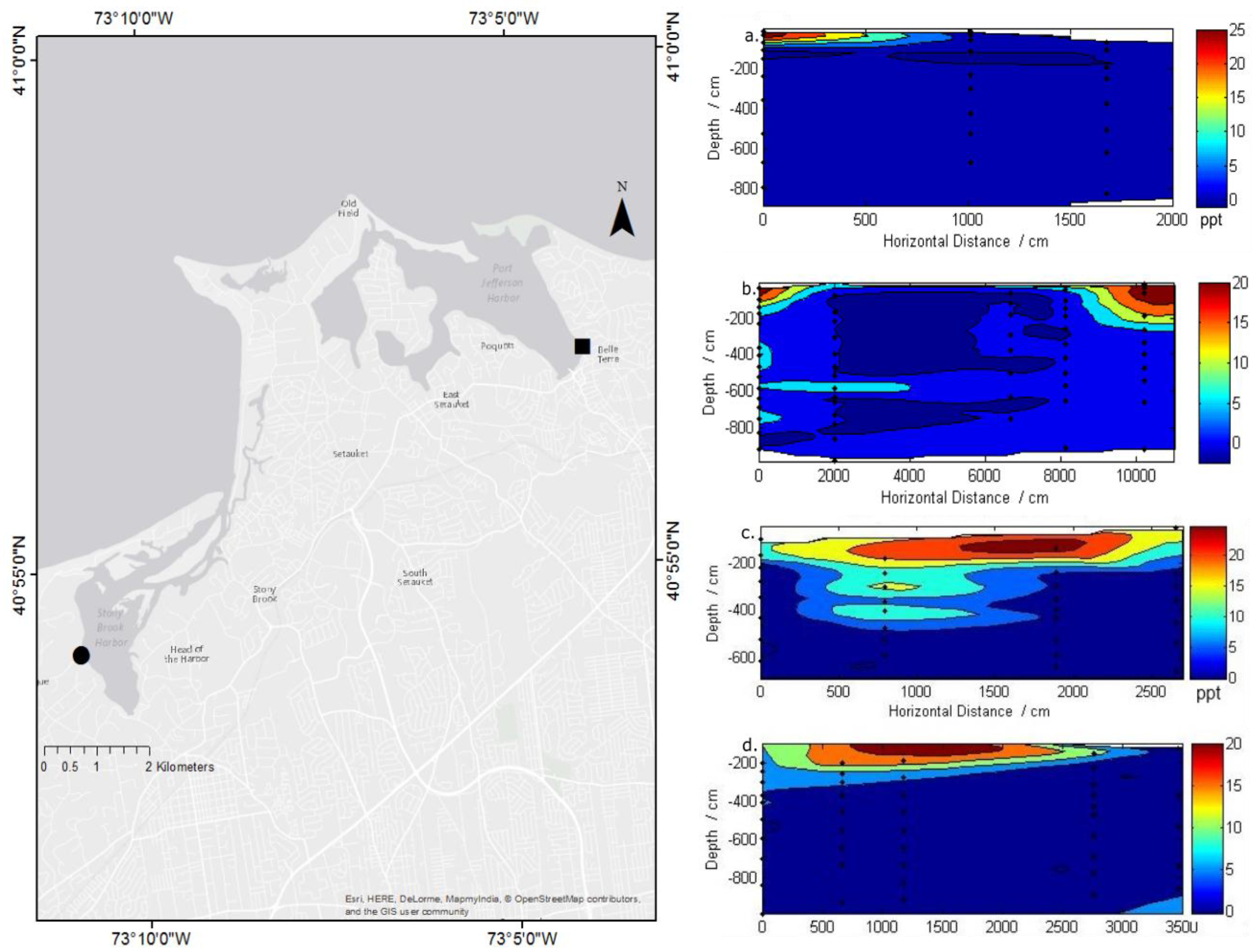
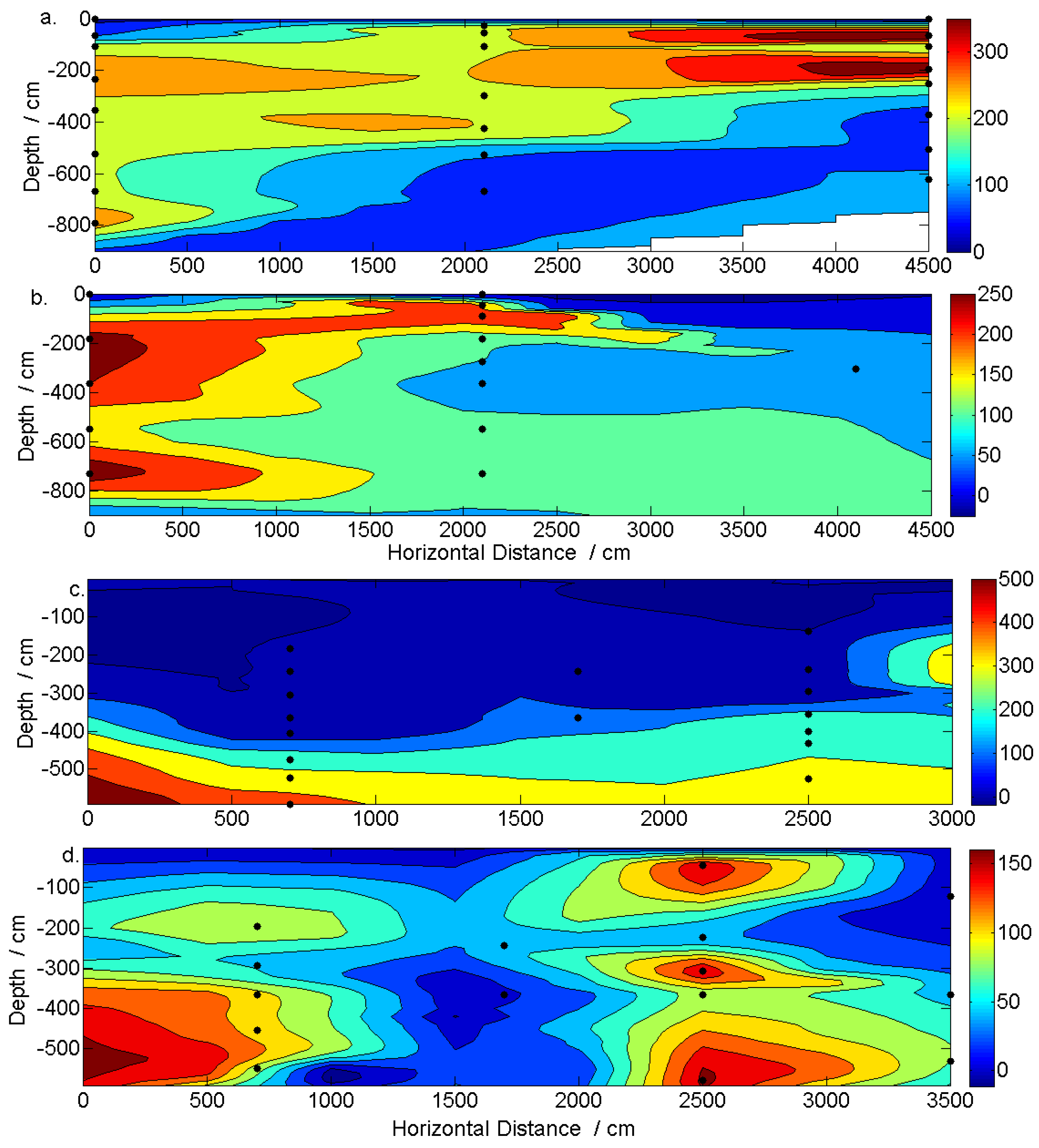
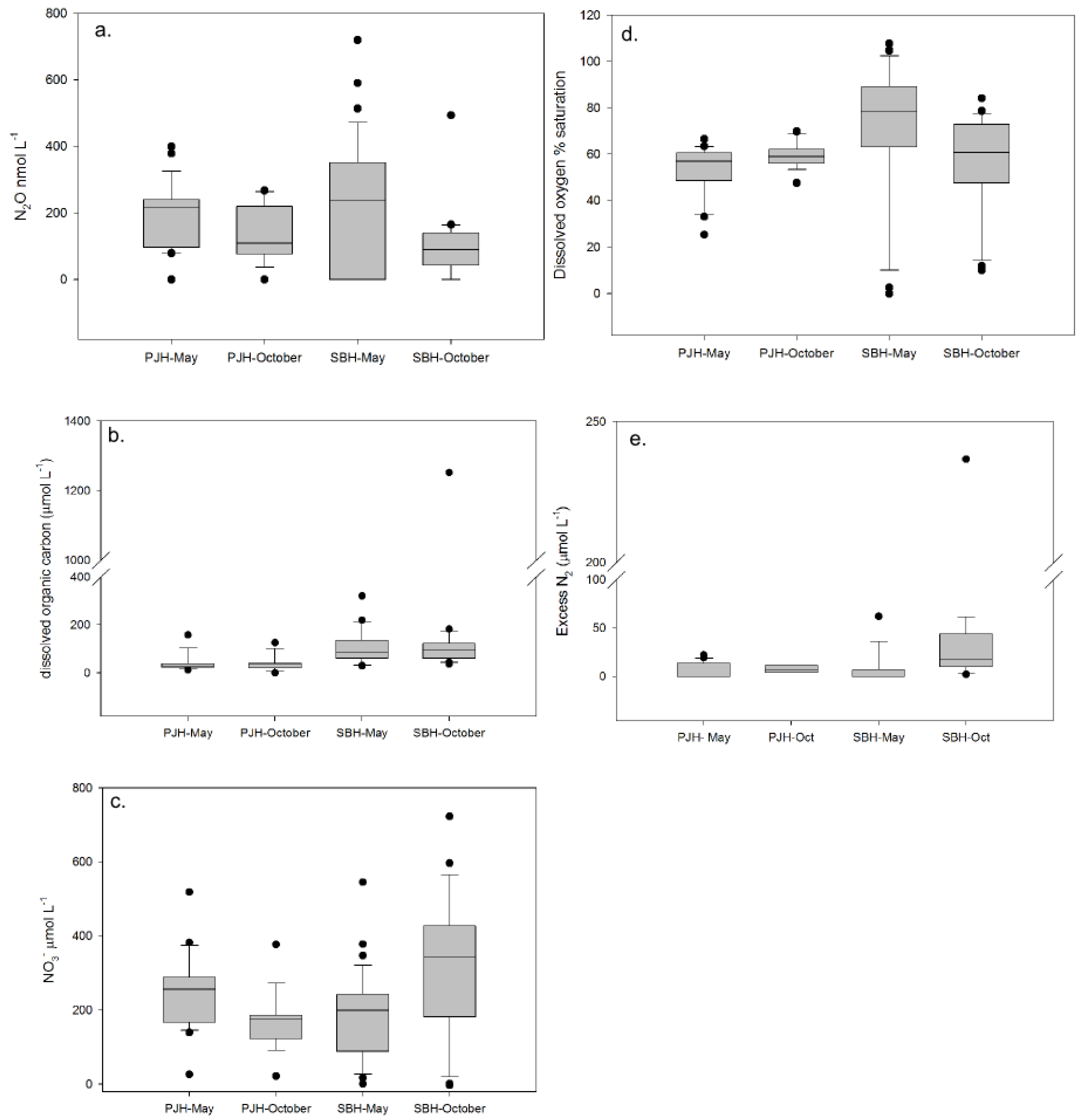
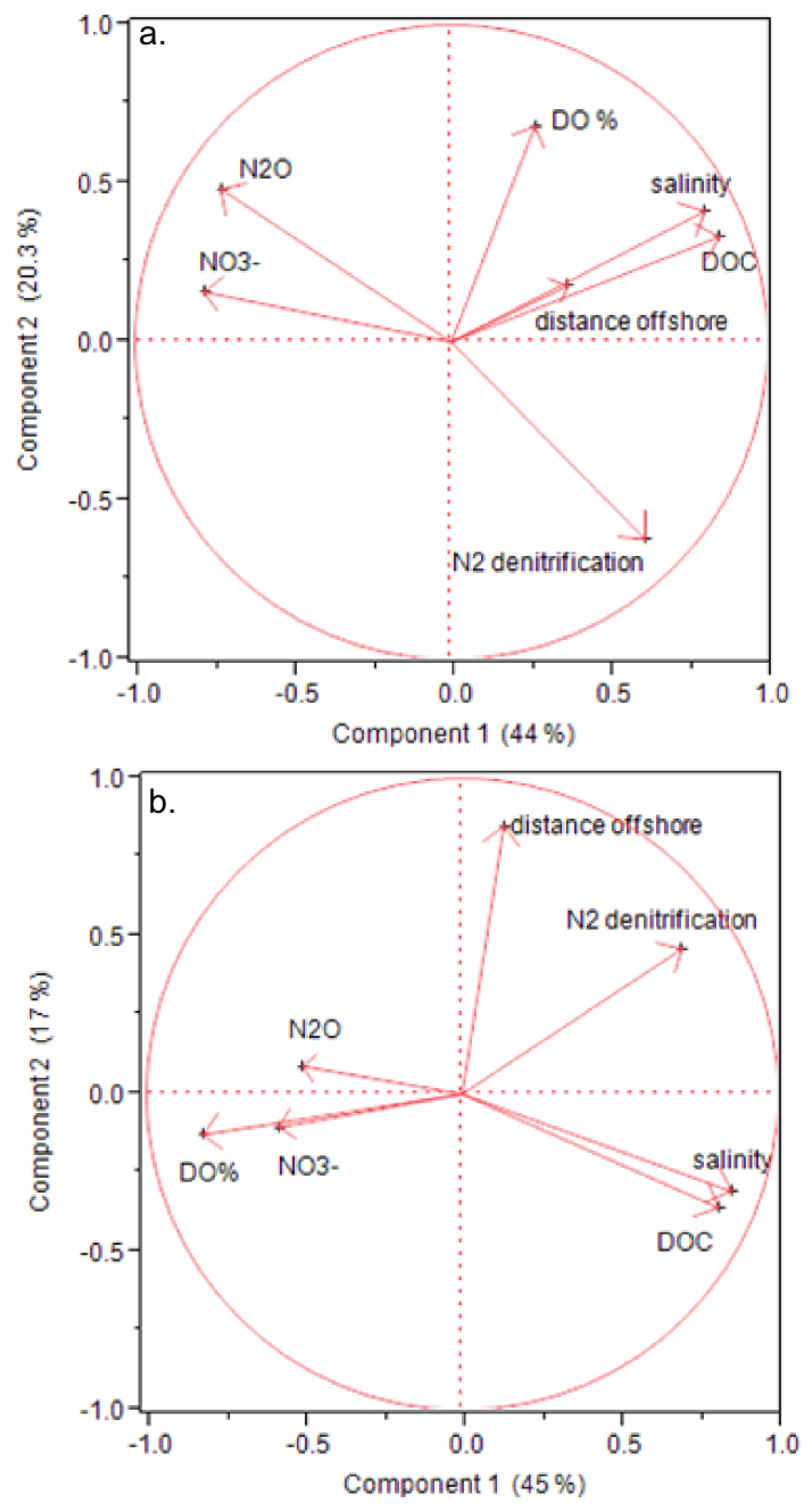
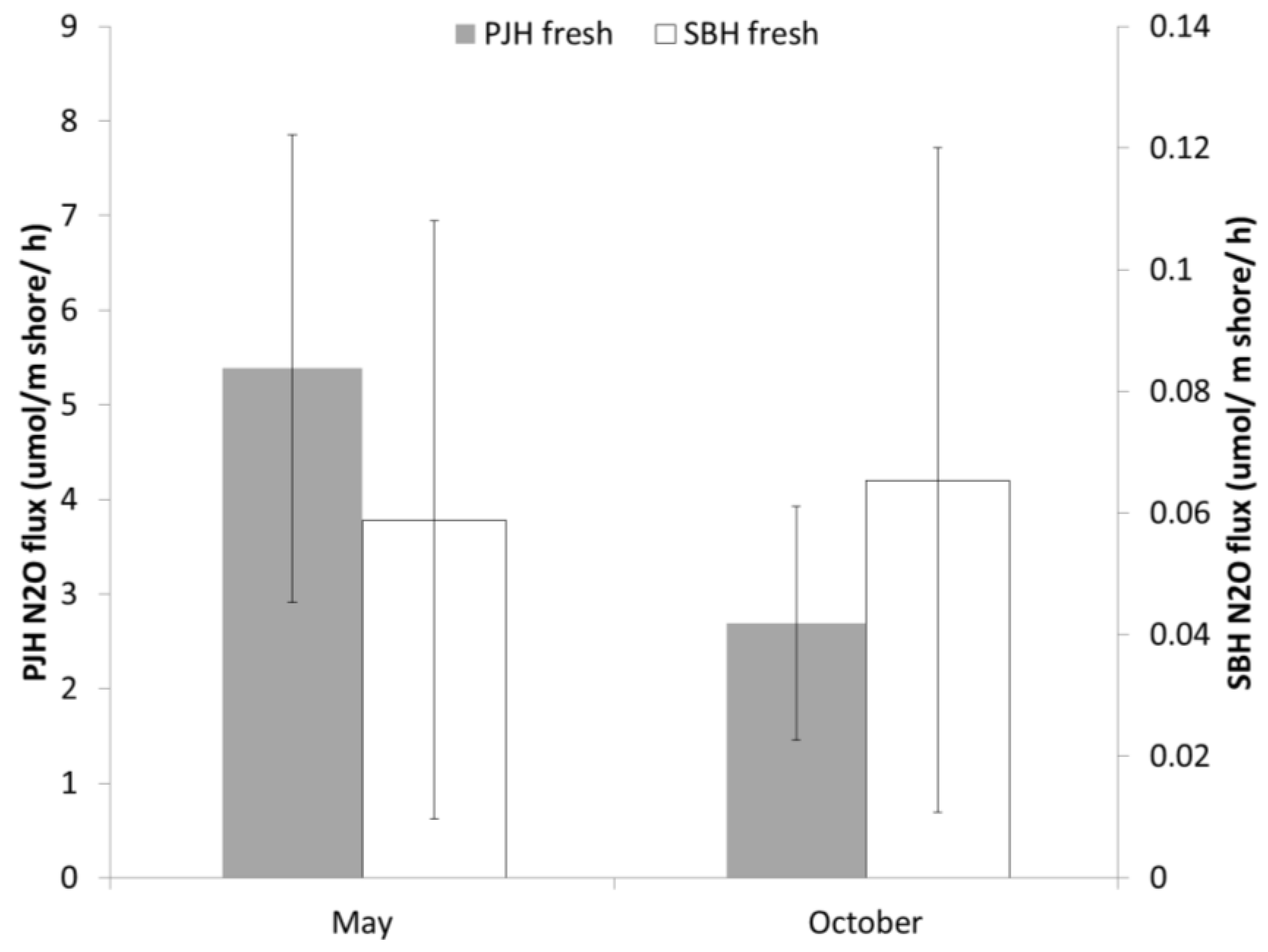
| Month | PJH | SBH | ||
|---|---|---|---|---|
| Mean | Median | Mean | Median | |
| May | 0.0042 | 0.0008 | 0.0009 | 0.0011 |
| October | 0.0008 | 0.0008 | 0.0006 | 0.0002 |
© 2016 by the authors; licensee MDPI, Basel, Switzerland. This article is an open access article distributed under the terms and conditions of the Creative Commons Attribution license ( http://creativecommons.org/licenses/by/4.0/).
Share and Cite
Young, C.; Martin, J.B.; Hanson, G.N. Controls on Nitrous Oxide Production in, and Fluxes from a Coastal Aquifer in Long Island, NY, USA. J. Mar. Sci. Eng. 2016, 4, 71. https://doi.org/10.3390/jmse4040071
Young C, Martin JB, Hanson GN. Controls on Nitrous Oxide Production in, and Fluxes from a Coastal Aquifer in Long Island, NY, USA. Journal of Marine Science and Engineering. 2016; 4(4):71. https://doi.org/10.3390/jmse4040071
Chicago/Turabian StyleYoung, Caitlin, Jonathan B. Martin, and Gilbert N. Hanson. 2016. "Controls on Nitrous Oxide Production in, and Fluxes from a Coastal Aquifer in Long Island, NY, USA" Journal of Marine Science and Engineering 4, no. 4: 71. https://doi.org/10.3390/jmse4040071
APA StyleYoung, C., Martin, J. B., & Hanson, G. N. (2016). Controls on Nitrous Oxide Production in, and Fluxes from a Coastal Aquifer in Long Island, NY, USA. Journal of Marine Science and Engineering, 4(4), 71. https://doi.org/10.3390/jmse4040071






